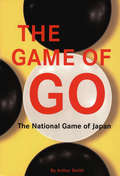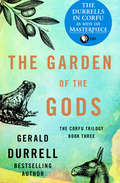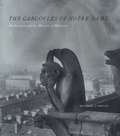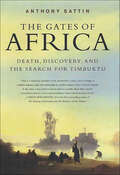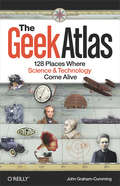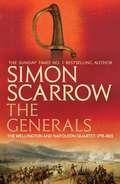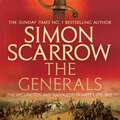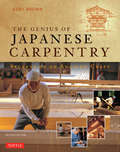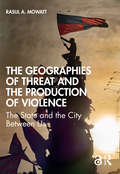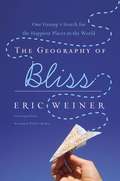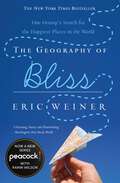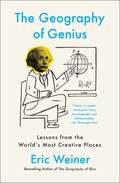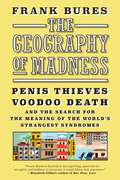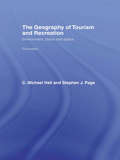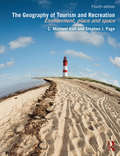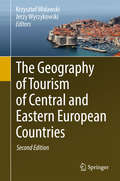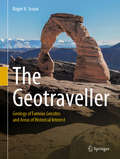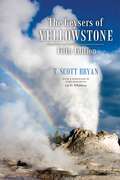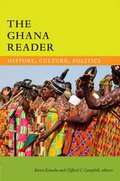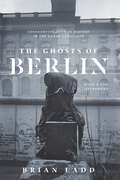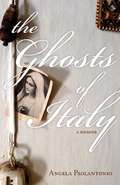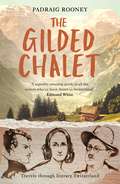- Table View
- List View
The Game of Go
by Arthur SmithPassing from China, where it was developed over 3,000 years ago, to Japan, where it today commands a vast and enthusiastic following, Go is probably the oldest intellectual game in the world. Similar to chess, it leaves nothing to chance, requiring great strategy and carefully plotted campaigns to achieve an impregnable position, block enemies from lines of communication and win a series of battles. To penetrate this complicated, challenging game requires a great guide- and this is it. Unsurpassable in its clarity and comprehensiveness, The Game of Go has been the classic guide to the game since it was first published in 1956.
The Garden of the Gods: My Family And Other Animals; Birds, Beasts And Relatives; And The Garden Of The Gods (The Corfu Trilogy #3)
by Gerald DurrellPart of the trilogy of memoirs that inspired the television show The Durrells in Corfu: A naturalist&’s adventures with animals—and humans—on a Greek island. When his family moved to a Greek island, young naturalist Gerald Durrell was able to indulge his passion for wildlife of all sorts as he discovered the new world around him—and the creatures and people who inhabited it. Indeed, Durrell&’s years growing up on Corfu would inspire the rest of his life. In addition to his tales of wild animals, Durrell recounts stories about his even wilder family—including his widowed mother, Louisa, and elder siblings Lawrence, Leslie, and Margo—with undeniable wit and humor. The final chapter in Durrell&’s reflections on his family&’s time in Greece before the start of World War II, The Garden of the Gods is a fascinating look at the childhood of a naturalist who was ahead of his time. This ebook features an illustrated biography of Gerald Durrell including rare photos from the author&’s estate.
The Gargoyles of Notre Dame: Medievalism and the Monsters of Modernity
by Michael CamilleMost of the seven million people who visit the cathedral of Notre Dame in Paris each year probably do not realize that the legendary gargoyles adorning this medieval masterpiece were not constructed until the nineteenth century.
The Gates of Africa: Death, Discovery, and the Search for Timbuktu
by Anthony SattinLondon, 1788: a group of British gentlemen---geographers, scholars, politicians, humanitarians, and traders---decide it is time to solve the mysteries of Africa's unknown interior regions. Inspired by the Enlightenment quest for knowledge, they consider it a slur on the age that the interior of Africa still remains a mystery, that maps of the "dark continent" are populated with mythical beasts, imaginary landmarks, and fabled empires. As well, they hoped that more accurate knowledge of Africa would aid in the abolition of the slave trade.These men, a mixed group of soldiers and gentlemen, ex-convicts, and social outcasts, form the African Association, the world's first geographical society, and over several decades send hardened, grizzled adventurers to replace speculation with facts and remove the beasts from the maps. The explorers who ventured forth included Mungo Park, whose account of his travels would be a bestseller for more than a century; American John Ledyard; and Jean Louis Burckhardt, the discoverer of Petra and Abu Simbel. Their exploits would include grueling crossings of the Sahara, the exploration of the Nile, and--most dramatically--the search for the great River Niger and its legendary city of gold: Timbuktu. Anthony Sattin weaves the plotting of the London gentlemen and the experiences of their extraordinary explorers into a gripping account of high adventure, international intrigue, and geographical discovery. The Gates of Africa is a story of human courage and fatal ambition, a groundbreaking insight into the struggle to reveal the secrets of Africa.
The Geek Atlas: 128 Places Where Science and Technology Come Alive
by John Graham-CummingThe history of science is all around us, if you know where to look. With this unique traveler's guide, you'll learn about 128 destinations around the world where discoveries in science, mathematics, or technology occurred or is happening now. Travel to Munich to see the world's largest science museum, watch Foucault's pendulum swinging in Paris, ponder a descendant of Newton's apple tree at Trinity College, Cambridge, and more.Each site in The Geek Atlas focuses on discoveries or inventions, and includes information about the people and the science behind them. Full of interesting photos and illustrations, the book is organized geographically by country (by state within the U.S.), complete with latitudes and longitudes for GPS devices. Destinations include:Bletchley Park in the UK, where the Enigma code was brokenThe Alan Turing Memorial in Manchester, EnglandThe Horn Antenna in New Jersey, where the Big Bang theory was confirmedThe National Cryptologic Museum in Fort Meade, MarylandThe Trinity Test Site in New Mexico, where the first atomic bomb was explodedThe Joint Genome Institute in Walnut Creek, CaliforniaYou won't find tedious, third-rate museums, or a tacky plaque stuck to a wall stating that "Professor X slept here." Every site in this book has real scientific, mathematical, or technological interest -- places guaranteed to make every geek's heart pound a little faster. Plan a trip with The Geek Atlas and make your own discoveries along the way.
The Generals (Wellington and Napoleon 2)
by Simon ScarrowTHE GENERALS is the compelling second novel in Simon Scarrow's bestselling Wellington and Napoleon quartet. A must read for fans of Bernard Cornwell.In the turbulent aftermath of the French Revolution Napoleon Bonaparte stands accused of treachery and corruption. His reputation is saved by his skill in leading his men to victory in Italy and Egypt. But then he must restore order in France and find peace or victory over her enemies: England - and Arthur Wellesley (the future Duke of Wellington).Wellesley is leading a vast army in India, where British interests are under threat. The campaign will result in the creation of the Raj - the jewel in the British Empire's crown. Wellesley returns to England a hardened veteran and more determined than ever to end France's domination of Europe.Both Wellesley and Napoleon intend to win - whatever the cost. Who will ultimately succeed?
The Generals: (Revolution 2) (Revolution #2)
by Simon ScarrowTHE GENERALS is the compelling second novel in Simon Scarrow's bestselling Wellington and Napoleon quartet. A must read for fans of Robert Harris.In the turbulent aftermath of the French Revolution Napoleon Bonaparte stands accused of treachery and corruption. His reputation is saved by his skill in leading his men to victory in Italy and Egypt. But then he must restore order in France and find peace or victory over her enemies: England - and Arthur Wellesley (the future Duke of Wellington).Wellesley is leading a vast army in India, where British interests are under threat. The campaign will result in the creation of the Raj - the jewel in the British Empire's crown. Wellesley returns to England a hardened veteran and more determined than ever to end France's domination of Europe.Both Wellesley and Napoleon intend to win - whatever the cost. Who will ultimately succeed?
The Genius of Japanese Carpentry
by Azby BrownThis new edition of this Azby Brown architecural classic contains a new preface by Brown, fully revised chapters, along 25% new photography and in color for the first time.An extraordinary and ambitious work of architectural reconstruction is underway in twenty-first century Nara. The Genius of Japanese Carpentry is the story of the twelve-hundred-year-old Yakushiji monastery and the dedicated modern-day craftsmen who are working to restore what has been lost to the depredations of time, fire, and warfare.In the eighth century, anonymous carpenters first erected the intricately-designed timber temples and pagodas that compose the Yakushiji Buddhist monastery. Then as today, these buildings were considered marvels of architectural elegance and traditional Japanese craftsmanship. Although the full restoration will not be complete until 2030, one of the main temples, the Picture Hall, has been completely reconstructed, employing the original methods, architectural style, and largely the same woodworking technology as its predecessors. Azby Brown chronicles the Picture Hall's painstaking restoration through photographs, extensive interviews with the carpenters and woodworkers, and original drawings based on the plans of Japanese master carpenter Tsunekazu Nishioka. An inspiring testament to the craftsmen, their dedication to excellence, and their philosophy of work as personal fulfillment, The Genius of Japanese Carpentry offers detailed documentation of this singular project and a moving reminder of the humanity that bridges past and present.
The Geographies of Threat and the Production of Violence: The State and the City Between Us
by Rasul A MowattThe Geographies of Threat and the Production of Violence exposes the spatial processes of racialising, gendering, and classifying populations through the encoded urban infrastructure – from highways cleaving neighbourhoods to laws and policies fortifying even more unbreachable boundaries. This synthesis of narrative and theory resurrects neglected episodes of state violence and reveals how the built environment continues to enable it today within a range of cities throughout the world. Examples and discussions pull from colonial pasts and presents, of old strategic settlements turned major modern cities in the United States and elsewhere that link to the physical and legal structures concentrating a populace into neighbourhoods that prep them for a lifetime of conscripted and carceral service to the State.
The Geography of Bliss: One Grump's Search for the Happiest Places in the World
by Eric WeinerWeiner investigates why some places are happy, notably the Netherlands, Switzerland, Bhutan, Qatar, Iceland, Moldova, Thailand, Great Britain, India, and America.
The Geography of Bliss: One Grump's Search for the Happiest Places in the World
by Eric WeinerNow a new series on Peacock with Rainn Wilson, THE GEOGRAPHY OF BLISS is part travel memoir, part humor, and part twisted self-help guide that takes the viewer across the globe to investigate not what happiness is, but WHERE it is. Are people in Switzerland happier because it is the most democratic country in the world? Do citizens of Qatar, awash in petrodollars, find joy in all that cash? Is the King of Bhutan a visionary for his initiative to calculate Gross National Happiness? Why is Asheville, North Carolina so damn happy? In a unique mix of travel, psychology, science and humor, Eric Weiner answers those questions and many others, offering travelers of all moods some interesting new ideas for sunnier destinations and dispositions.
The Geography of Genius: A Search for the World's Most Creative Places from Ancient Athens to Silicon Valley
by Eric Weiner"An intellectual odyssey, a traveler's diary, and a comic novel all rolled into one. Smart, original, and utterly delightful." --Daniel Gilbert, Harvard professor and bestselling author of Stumbling on Happiness "A charming mix of history and wisdom cloaked as a rollicking travelogue." --Walter Isaacson, bestselling author of Steve Jobs Travel the world with Eric Weiner, the New York Times bestselling author of The Geography of Bliss, as he journeys from Athens to Silicon Valley--and throughout history, too--to show how creative genius flourishes in specific places at specific times.In The Geography of Genius, acclaimed travel writer Weiner sets out to examine the connection between our surroundings and our most innovative ideas. He explores the history of places, like Vienna of 1900, Renaissance Florence, ancient Athens, Song Dynasty Hangzhou, and Silicon Valley, to show how certain urban settings are conducive to ingenuity. And, with his trademark insightful humor, he walks the same paths as the geniuses who flourished in these settings to see if the spirit of what inspired figures like Socrates, Michelangelo, and Leonardo remains. In these places, Weiner asks, "What was in the air, and can we bottle it?" This link can be traced back through history: Darwin's theory of evolution gelled while he was riding in a carriage. Freud did his best thinking at this favorite coffee house. Beethoven, like many geniuses, preferred long walks in the woods. Sharp and provocative, The Geography of Genius redefines the argument about how genius came to be. His reevaluation of the importance of culture in nurturing creativity is an informed romp through history that will surely jumpstart a national conversation.
The Geography of Madness: Penis Thieves, Voodoo Death, and the Search for the Meaning of the World's Strangest Syndromes
by Frank BuresJon Ronson meets David Grann in this fascinating, wildly entertaining adventure and travel story about how culture can make us go totally insaneThe Geography of Madness is an investigation of "culture-bound" syndromes, which are far stranger than they sound. Why is it, for example, that some men believe, against all reason, that vandals stole their penises, even though they're in good physical shape? In The Geography of Madness, acclaimed magazine writer Frank Bures travels around the world to trace culture-bound syndromes to their sources--and in the process, tells a remarkable story about the strange things all of us believe.From the Hardcover edition.
The Geography of Tourism and Recreation: Environment, Place and Space
by C. Michael Hall Stephen J. PageHighlighting the inter-relationships between tourism, leisure and recreation, this revised edition introduces growing theoretical debates (from geography and the wider social science arena) to assess how new conceptualizations of tourism and leisure are advancing knowledge and understanding. Underpinning this book is the concept of the evolving nature of geography and social science, and their role in leading the analysis of the leisure phenomenon as a living subject, which has recently seen significant contributions from the new cultural geographies of consumption and leisure. These developments are clearly introduced, giving readers new to the subject area bite-sized introductions to key issues. Whilst this third edition retains the successful format and structure of previous editions, making it attractive and user-friendly to students without being overwhelming, it is completely revised and redeveloped to accommodate new case studies, insights, summary points and learning objectives. It is the only book to systematically compare and contrast in a spatial context, tourism and recreation in relation to leisure time, and its encyclopaedic reference section provides an excellent resource for new students. Retaining a global focus, this edition now features a greater emphasis on North America, and investigates the importance of less developed countries and the critical issues surrounding inequality, exploitation, underdevelopment and globalization as powerful forces affecting tourism and leisure.
The Geography of Tourism and Recreation: Environment, Place and Space
by C. Michael Hall Stephen J. PageThis fourth edition of The Geography of Tourism and Recreation provides students with a comprehensive introduction to the interrelationship between tourism, leisure and recreation from geographical and social science perspectives. It still remains the only book to systematically compare and contrast in a spatial context, tourism and recreation in relation to leisure time, offering insight into the demand, supply, planning, destination management and impacts of tourism and recreation.Whilst retaining its accessible style and approach this edition has been significantly updated to reflect recent developments and new concepts from geography which are beginning to permeate the tourism and recreational field. New features include: Content on the most recent developments, climate change, sustainability, mobilities and crisis management in time and space as well as trends such as low cost airlines and the control of land transport by transnational operators in the EU such as Arriva. More attention to management issues such as innovation and the spatial consequences for tourism and leisure development. New case studies and examples to showcase real life issues, from both developed and developing countries, especially the US, China and South Africa. Completely revised and redeveloped to accommodate new, user- friendly features: case studies, insights, summary points and learning objectives. Written by leading academics, this is essential reading for all tourism, geography, leisure and recreation students.
The Geography of Tourism of Central and Eastern European Countries
by Krzysztof Widawski Jerzy WyrzykowskiThis book presents a comprehensive overview of the tourism market development in Central and Eastern European countries. It is divided into 13 chapters, including a chapter dedicated to Belarus, all richly illustrated with colorful maps and illustrations. The book presents the output of international conferences organized every two years by the Department of Regional Geography and Tourism of the University of Wroclaw which have served as inspiration for this book. Chapter 1 provides the characteristics of 20 post-communist countries of the region on the international tourism market and it sets the background and context for the following chapters. Chapters 2 to 13 present the condition of research on tourism, tourist attractions, tourist infrastructure, tourism movement, main types of tourism as well as tourist regionalization in 12 Central and Eastern European countries. All chapters have been updated with reference to the statistics. This book is a revised and updated version of "The Geography of Tourism of Central and Eastern Europe Countries" published by the Department of Regional Geography and Tourism of Wroclaw University in 2012. It has been developed by a group of specialists through their exchange of research experience in the scope of international tourism in Central and Eastern Europe.
The Geotraveller: Geology of Famous Geosites and Areas of Historical Interest
by Roger N. ScoonThis book describes famous geosites and historical localities in national parks and conservation areas from North America, East Africa, and Europe. The geosites include iconic landforms associated with active volcanoes, canyons, glaciated landscapes, natural rock monoliths, and rifts. The potential for geotourism in historical localities such as the famous Greco-Roman antiquities of Greece, Italy, and Turkey, is emphasised.Some of the geosites and historical localities provide evidence that previous civilizations coped with active geology and major climatic cycles, whilst others reveal evidence of famous geological events recognized in history and ancient mythology that helped shape our current civilization.The book assists tour guides and visitors (both geologists and non-specialists) interested in geotourism by providing an understanding of geological processes in the national parks and historical locations with the assistance of photographs and simplified geological maps.
The Geysers of Yellowstone, Fifth Edition
by T. Scott BryanThis new edition of The Geysers of Yellowstone is the most up-to-date and comprehensive reference to the geysers of Yellowstone National Park, describing in detail each of the more than five hundred geysers in the park. The entire text has been revised and geyser descriptions have been updated based on activity observed through early 2018. Information about a number of significant new geyser developments has been added, as well as recent knowledge about some of the world’s geyser fields outside Yellowstone. Both a reference work and a fine introduction to the nature of geyser activity, this popular field guide includes a glossary of key terms, a comprehensive appendix that discusses other geyser areas of the world, detailed maps of each geyser basin, and tables for easy reference. The Geysers of Yellowstone will continue to serve geyser gazers as well as newcomers to geothermal phenomena for years to come.
The Ghana Reader: History, Culture, Politics
by Kwasi Konadu Clifford C. CampbellCovering 500 years of Ghana's history, The Ghana Reader provides a multitude of historical, political, and cultural perspectives on this iconic African nation. Whether discussing the Asante kingdom and the Gold Coast's importance to European commerce and transatlantic slaving, Ghana's brief period under British colonial rule, or the emergence of its modern democracy, the volume's eighty selections emphasize Ghana's enormous symbolic and pragmatic value to global relations. They also demonstrate that the path to fully understanding Ghana requires acknowledging its ethnic and cultural diversity and listening to its population's varied voices. Readers will encounter selections written by everyone from farmers, traders, and the clergy to intellectuals, politicians, musicians, and foreign travelers. With sources including historical documents, poems, treaties, articles, and fiction, The Ghana Reader conveys the multiple and intersecting histories of Ghana's development as a nation, its key contribution to the formation of the African diaspora, and its increasingly important role in the economy and politics of the twenty-first century.
The Ghosts of Berlin: Confronting German History in the Urban Landscape
by Brian LaddIn the twenty years since its original publication, The Ghosts of Berlin has become a classic, an unparalleled guide to understanding the presence of history in our built environment, especially in a space as historically contested—and emotionally fraught—as Berlin. Brian Ladd examines the ongoing conflicts radiating from the remarkable fusion of architecture, history, and national identity in Berlin. Returning to the city frequently, Ladd continues to survey the urban landscape, traversing its ruins, contemplating its buildings and memorials, and carefully deconstructing the public debates and political controversies emerging from its past.
The Ghosts of Italy, First Edition
by Angela PaolantonioThe Ghosts of Italy is Angela Paolantonio's memoir of how she first discovers and then returns to live in the remote mountain village in Southern Italy where her grandparents were born. She sets out late one November, just after having celebrated Thanksgiving alone on a rooftop in Rome, the spirit of her ancestors guiding her in. "I really didn't know I was searching for anything till I got here," she says. "Then I realized what I was missing and what it meant." Angela Paolantonio's archetypal journey to the village of the ghosts of her ancestors is a unique yet universal woman's story. She ventures across the threshold of a lost world, reclaims it, and falls deeply in love along the way - with the town and its residents, the landscape, and the Handsome Man from Macchiursi. She follows the clues to rediscover her spirit and the spirit of her grandmother, and namesake, whose memory had been lost to her, locked inside her father's heart.
The Gilded Chalet: Off-Piste in Literary Switzerland
by Padraig Rooney'With a sharp eye for detail and a historian's capacious knowledge, Padraig Rooney has written a superbly amusing guide to all the writers who've been drawn to or emerged from Switzerland. This is a book that should be stuffed into every stocking - the perfect Christmas gift!' -Edmund White, author of The FlâneurRainy summer of 1816. Paparazzi train their telescopes across Lake Geneva on the hanky-panky of Byron, Shelley and their womenfolk. Mary Shelley is inspired to write Frankenstein. Byron diets and dashes off The Prisoner of Chillon while his doctor, 'Pollydolly', gives birth to The Vampyre. Percy Shelley almost drowns in the lake. Together they put Switzerland on the literary map.From Caesar, Rousseau and the Romantics, from Conan Doyle to le Carré, Hesse and Highsmith writers have scratched their names on the Swiss chalet. In the nineteenth century they came for fresh air, fresh milk and the sublime scenery, escaping tuberculosis and smog. Switzerland became spa central, a place of health fads, luxury hotels and nude sunbathing. Sherlock Holmes fell to his death only to be resurrected. H. G. Wells thought he'd died and gone to heaven. Hermann Hesse had himself buried to the neck as a cure for alcoholism. Thomas Mann wrote The Magic Mountain and lusted after the sailor suits.Neutral Switzerland became a haven in the twentieth century for Borges, Joyce, Remarque, Hemingway, Fitzgerald, Nabokov and Highsmith. They wrote their classic works up some secluded valley, in a coldwater flat in Zürich or in a five-star hotel. The Gilded Chalet took them in and gave them a suite with a view.Anarchists, spies and detectives came too. Sherlock Holmes, Maugham's Ashenden, Fleming's Bond, le Carré's spooks and double agents. Glauser and Dürrenmatt invented Swiss noir - not a chocolate but a style. Behind the squeaky-clean facade, Swiss and foreign writers often found something rotten in the state. Laundered art and money, the world's slush funds, daylight robbery.Switzerland's travel writers Maillart, Eberhardt, Schwarzenbach and Bouvier couldn't wait to make their escape to a bigger air and a warmer climate. The Gilded Chalet is crammed with old lederhosen and new butterflies, spas and spies, fool's gold and numbered accounts.Part detective work, part treasure chest, full of history and scandal, award-winning writer Padraig Rooney takes you on a grand tour of two centuries of great writing by both Swiss and foreign authors and shows how Switzerland has always been at the center of literary Europe.
The Gilded Chalet: Off-Piste in Literary Switzerland
by Padraig Rooney'With a sharp eye for detail and a historian's capacious knowledge, Padraig Rooney has written a superbly amusing guide to all the writers who've been drawn to or emerged from Switzerland. This is a book that should be stuffed into every stocking - the perfect Christmas gift!' -Edmund White, author of The FlâneurRainy summer of 1816. Paparazzi train their telescopes across Lake Geneva on the hanky-panky of Byron, Shelley and their womenfolk. Mary Shelley is inspired to write Frankenstein. Byron diets and dashes off The Prisoner of Chillon while his doctor, 'Pollydolly', gives birth to The Vampyre. Percy Shelley almost drowns in the lake. Together they put Switzerland on the literary map.From Caesar, Rousseau and the Romantics, from Conan Doyle to le Carré, Hesse and Highsmith writers have scratched their names on the Swiss chalet. In the nineteenth century they came for fresh air, fresh milk and the sublime scenery, escaping tuberculosis and smog. Switzerland became spa central, a place of health fads, luxury hotels and nude sunbathing. Sherlock Holmes fell to his death only to be resurrected. H. G. Wells thought he'd died and gone to heaven. Hermann Hesse had himself buried to the neck as a cure for alcoholism. Thomas Mann wrote The Magic Mountain and lusted after the sailor suits.Neutral Switzerland became a haven in the twentieth century for Borges, Joyce, Remarque, Hemingway, Fitzgerald, Nabokov and Highsmith. They wrote their classic works up some secluded valley, in a coldwater flat in Zürich or in a five-star hotel. The Gilded Chalet took them in and gave them a suite with a view.Anarchists, spies and detectives came too. Sherlock Holmes, Maugham's Ashenden, Fleming's Bond, le Carré's spooks and double agents. Glauser and Dürrenmatt invented Swiss noir - not a chocolate but a style. Behind the squeaky-clean facade, Swiss and foreign writers often found something rotten in the state. Laundered art and money, the world's slush funds, daylight robbery.Switzerland's travel writers Maillart, Eberhardt, Schwarzenbach and Bouvier couldn't wait to make their escape to a bigger air and a warmer climate. The Gilded Chalet is crammed with old lederhosen and new butterflies, spas and spies, fool's gold and numbered accounts.Part detective work, part treasure chest, full of history and scandal, award-winning writer Padraig Rooney takes you on a grand tour of two centuries of great writing by both Swiss and foreign authors and shows how Switzerland has always been at the center of literary Europe.
The Gilded Chalet: Off-Piste in Literary Switzerland
by Padraig Rooney'With a sharp eye for detail and a historian's capacious knowledge, Padraig Rooney has written a superbly amusing guide to all the writers who've been drawn to or emerged from Switzerland. This is a book that should be stuffed into every stocking - the perfect Christmas gift!' -Edmund White, author of The FlâneurRainy summer of 1816. Paparazzi train their telescopes across Lake Geneva on the hanky-panky of Byron, Shelley and their womenfolk. Mary Shelley is inspired to write Frankenstein. Byron diets and dashes off The Prisoner of Chillon while his doctor, 'Pollydolly', gives birth to The Vampyre. Percy Shelley almost drowns in the lake. Together they put Switzerland on the literary map.From Caesar, Rousseau and the Romantics, from Conan Doyle to le Carré, Hesse and Highsmith writers have scratched their names on the Swiss chalet. In the nineteenth century they came for fresh air, fresh milk and the sublime scenery, escaping tuberculosis and smog. Switzerland became spa central, a place of health fads, luxury hotels and nude sunbathing. Sherlock Holmes fell to his death only to be resurrected. H. G. Wells thought he'd died and gone to heaven. Hermann Hesse had himself buried to the neck as a cure for alcoholism. Thomas Mann wrote The Magic Mountain and lusted after the sailor suits.Neutral Switzerland became a haven in the twentieth century for Borges, Joyce, Remarque, Hemingway, Fitzgerald, Nabokov and Highsmith. They wrote their classic works up some secluded valley, in a coldwater flat in Zürich or in a five-star hotel. The Gilded Chalet took them in and gave them a suite with a view.Anarchists, spies and detectives came too. Sherlock Holmes, Maugham's Ashenden, Fleming's Bond, le Carré's spooks and double agents. Glauser and Dürrenmatt invented Swiss noir - not a chocolate but a style. Behind the squeaky-clean facade, Swiss and foreign writers often found something rotten in the state. Laundered art and money, the world's slush funds, daylight robbery.Switzerland's travel writers Maillart, Eberhardt, Schwarzenbach and Bouvier couldn't wait to make their escape to a bigger air and a warmer climate. The Gilded Chalet is crammed with old lederhosen and new butterflies, spas and spies, fool's gold and numbered accounts.Part detective work, part treasure chest, full of history and scandal, award-winning writer Padraig Rooney takes you on a grand tour of two centuries of great writing by both Swiss and foreign authors and shows how Switzerland has always been at the center of literary Europe.
The Gilded Chalet: Off-Piste in Literary Switzerland
by Padraig Rooney'With a sharp eye for detail and a historian's capacious knowledge, Padraig Rooney has written a superbly amusing guide to all the writers who've been drawn to or emerged from Switzerland. This is a book that should be stuffed into every stocking - the perfect Christmas gift!' -Edmund White, author of The FlâneurRainy summer of 1816. Paparazzi train their telescopes across Lake Geneva on the hanky-panky of Byron, Shelley and their womenfolk. Mary Shelley is inspired to write Frankenstein. Byron diets and dashes off The Prisoner of Chillon while his doctor, 'Pollydolly', gives birth to The Vampyre. Percy Shelley almost drowns in the lake. Together they put Switzerland on the literary map.From Caesar, Rousseau and the Romantics, from Conan Doyle to le Carré, Hesse and Highsmith writers have scratched their names on the Swiss chalet. In the nineteenth century they came for fresh air, fresh milk and the sublime scenery, escaping tuberculosis and smog. Switzerland became spa central, a place of health fads, luxury hotels and nude sunbathing. Sherlock Holmes fell to his death only to be resurrected. H. G. Wells thought he'd died and gone to heaven. Hermann Hesse had himself buried to the neck as a cure for alcoholism. Thomas Mann wrote The Magic Mountain and lusted after the sailor suits.Neutral Switzerland became a haven in the twentieth century for Borges, Joyce, Remarque, Hemingway, Fitzgerald, Nabokov and Highsmith. They wrote their classic works up some secluded valley, in a coldwater flat in Zürich or in a five-star hotel. The Gilded Chalet took them in and gave them a suite with a view.Anarchists, spies and detectives came too. Sherlock Holmes, Maugham's Ashenden, Fleming's Bond, le Carré's spooks and double agents. Glauser and Dürrenmatt invented Swiss noir - not a chocolate but a style. Behind the squeaky-clean facade, Swiss and foreign writers often found something rotten in the state. Laundered art and money, the world's slush funds, daylight robbery.Switzerland's travel writers Maillart, Eberhardt, Schwarzenbach and Bouvier couldn't wait to make their escape to a bigger air and a warmer climate. The Gilded Chalet is crammed with old lederhosen and new butterflies, spas and spies, fool's gold and numbered accounts.Part detective work, part treasure chest, full of history and scandal, award-winning writer Padraig Rooney takes you on a grand tour of two centuries of great writing by both Swiss and foreign authors and shows how Switzerland has always been at the center of literary Europe.
